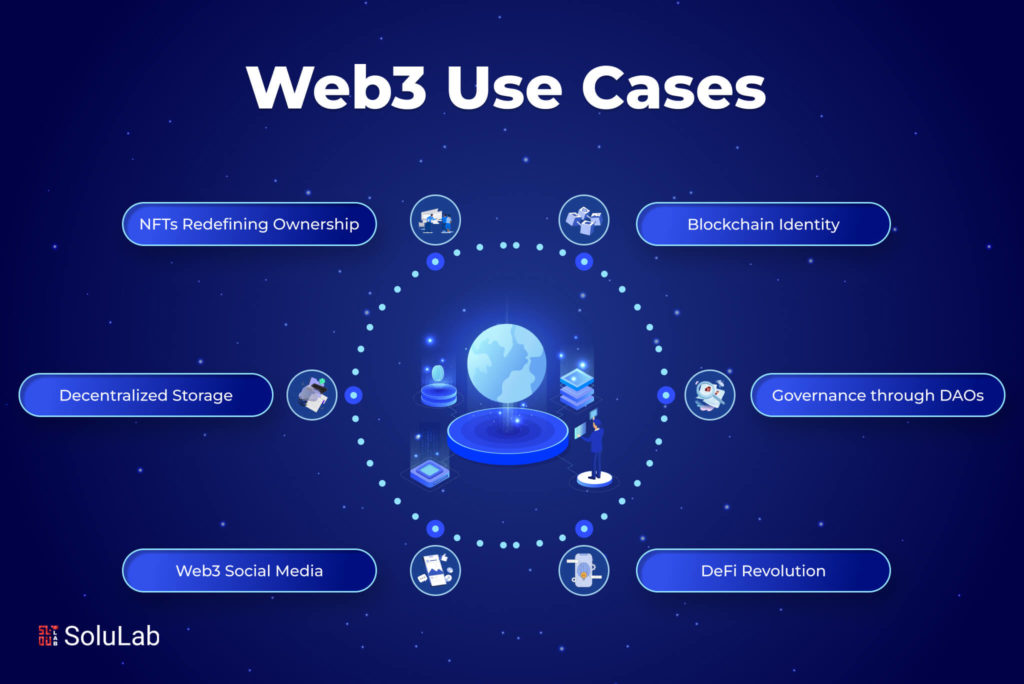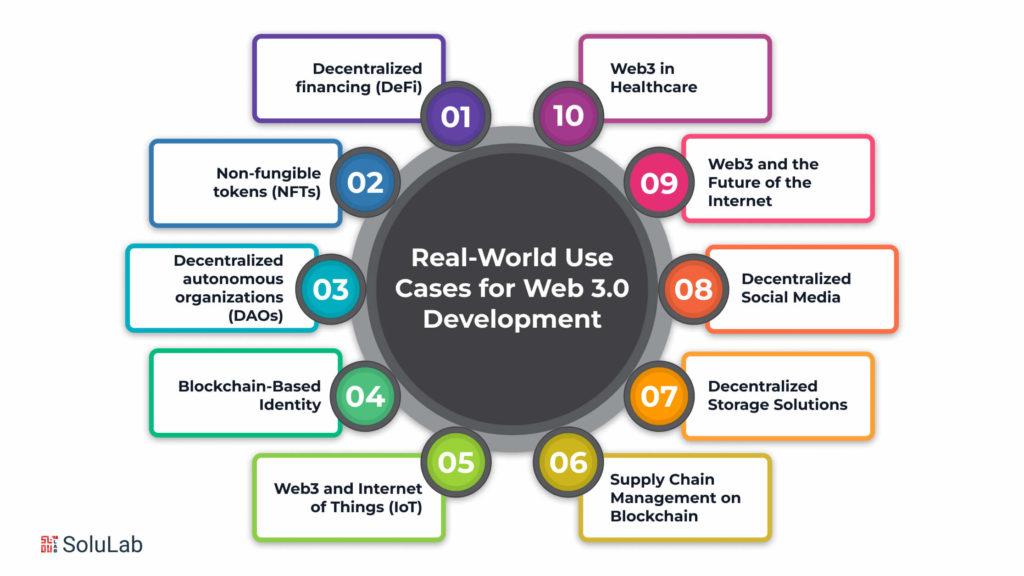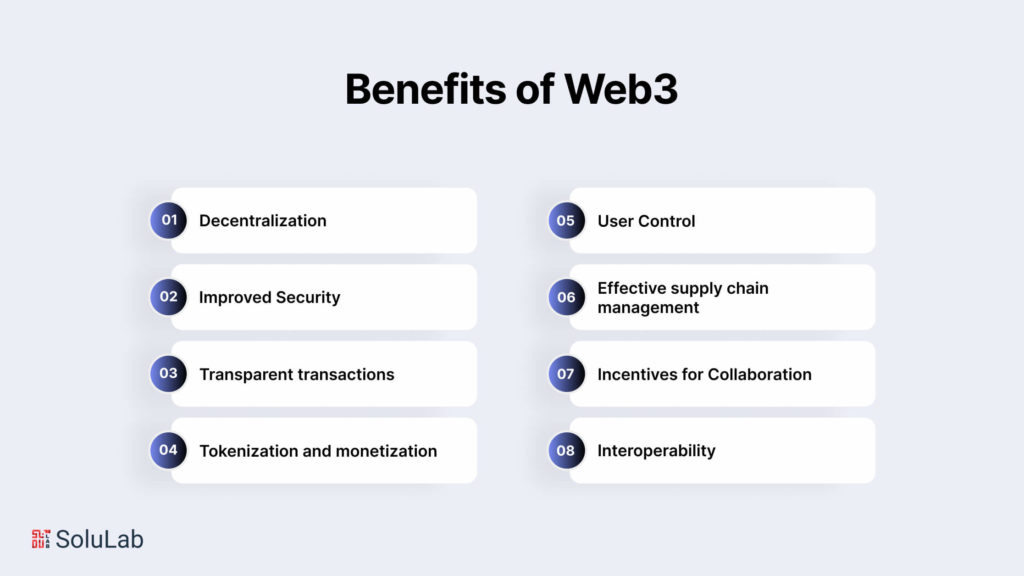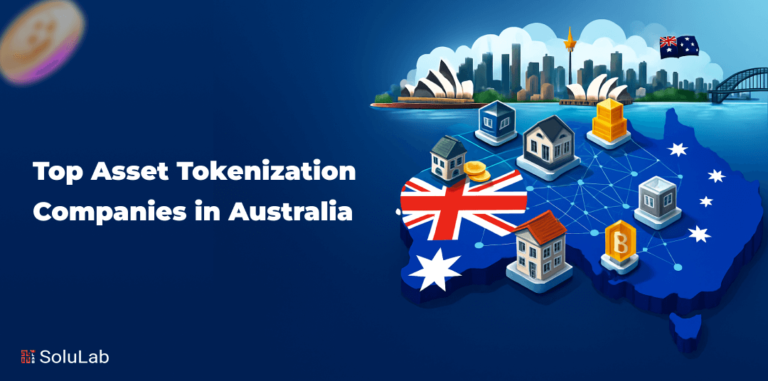
In the fast-changing internet ecosystem, the introduction of Web3 has become a major point of innovation and revolution. Web3, often known as the next generation of the internet, represents a change away from the traditional centralized architecture of Web1 and Web2 and toward a decentralized, user-centered approach. This phase provides Web3 application cases that are expected to revolutionize the digital environment in 2025 and beyond.
Web3 is the next version of the internet, based on decentralized protocols and powered by blockchain technology. Web3 aspires to give people more control over their data, identities, and digital interactions.
As we approach 2025, the importance of Web3 becomes more apparent. The top web3 use cases are set to transform many sectors and reshape our interactions with digital platforms. With an emphasis on user empowerment, privacy, and security, Web3 is well-positioned to solve the limits and shortcomings of its predecessors. The decentralized structure of Web3 alleviates concerns about data breaches, online privacy, and monopolistic control over information, giving people unparalleled autonomy over their digital presence.
What Makes Web3 Different from Web2?
In the constantly shifting web ecosystem, the shift from Web1 to Web2 represented a substantial increase in interaction and user engagement. What distinguishes Web3 from its predecessor, Web2, are its ground-breaking capabilities and creative use cases, which are expected to revolutionize the digital environment by 2025.
Web3, unlike Web2, is founded on the concept of decentralization. While Web2 is based on centralized servers and control structures controlled by companies, Web3 uses blockchain technology to share power among its users. This fundamental change eliminates the need for middlemen, resulting in a more transparent and trustless environment.
Web3 provides smart contracts, which are self-executing contracts with programmed terms embedded directly into lines of code. These contracts automate procedures, eliminating the need for intermediaries and facilitating transactions. Web 3.0 use cases include automating a variety of operations, ranging from financial transactions to supply chain management, hence increasing efficiency and cost-effectiveness.
What is Web3?
Instantaneous immersion in the digital world is emphasized by Web 3.0, this version of the web places a strong emphasis on using cryptocurrencies and blockchain technology, as well as owning personal data. Although 3.0 is still in its infancy, its objective is to create a decentralized, open Internet platform that provides users with more security and value. The goal is to make the internet more user-centric so that users can manage their data and transact with one another without relying on centralized organizations.
It is anticipated that Web 3.0 technologies will be open, distributed, and trustless. Open-source technology will be used in the construction of content creation platforms, ensuring transparency and accessibility. In a trustless setting, everyone will follow the zero-trust principles and network security will be extended to the furthest. This suggests that interaction between people, devices, and services is possible without a single authority’s consent.
Top 10 Real-World Use Cases for Web 3.0 Development

As we enter 2025, the internet’s transformation continues with the emergence of Web 3.0, which promises a decentralized and user-centric online experience. This article delves into the top ten real-world use cases for Web 3.0 development, highlighting the revolutionary impact of these advancements.
-
Decentralized financing (DeFi)
With the rise of Decentralized Finance (DeFi) development, Web3 use cases are gaining prominence in the financial world. Decentralized exchanges (DEX), lending and borrowing platforms, and yield farming are altering traditional financial institutions by giving consumers greater control over their assets.
-
Non-fungible tokens (NFTs)
Non-fungible tokens (NFTs) enable Web 3.0 application cases in the creative world. From digital art to tokenizing real-world assets, NFTs are transforming ownership by allowing artists and investors to interact in a decentralized marketplace.
-
Decentralized autonomous organizations (DAOs)
Web 3.0 lays the path for new governance systems, including Decentralized Autonomous Organizations (DAOs). These entities use transparent, community-driven decision-making procedures to challenge traditional hierarchical theories.
-
Blockchain-Based Identity
Web 3.0 use cases, notably blockchain-based identification solutions, represent a significant shift in identity management. Self-sovereign identification models improve privacy and security while giving users more control over their personal information.
-
Web3 and Internet of Things (IoT)
The combination of Web3 and IoT creates new prospects. Decentralized data markets and smart contracts in IoT applications improve security while also paving the way for a more connected and efficient digital environment.
-
Supply Chain Management on Blockchain
Blockchain’s impact on supply chain management is evident, with Web 3.0 applications emphasizing transparency and traceability. Tokenization lowers fraud and results in a more trustworthy and responsible supply chain.
-
Decentralized Storage Solutions
Web 3.0 addresses the difficulties of centralized storage with novel methods. Decentralized storage solutions, rewarded by tokenization, not only improve data security but also promote distributed and robust storage infrastructures.
-
Decentralized Social Media
Web 3.0 use cases improve the social media ecosystem by addressing challenges such as privacy and content regulation. Token-based incentives and community governance transform user participation, resulting in a more democratic online environment.
-
Web3 and the Future of the Internet
As Web 3.0 development proceeds, the influence on Internet infrastructure becomes clearer. A decentralized internet concept challenges the standard client-server architecture, offering a more user-centric and dependable online experience.
-
Web3 in Healthcare
Web 3.0 use cases arise in the healthcare industry, with blockchain-based systems enabling safe and interoperable health data management. Decentralized solutions enable patient privacy, data security, and efficient communication among healthcare stakeholders.
What are the Benefits of Web3?

Web3 has emerged as a game-changing fundamental shift, providing several benefits that are transforming the digital world. Web3 use cases range from decentralized banking to non-fungible coins, and they are having a lasting impact on how we engage with technology. Let us look at the several benefits that Web3 brings to the table.
-
Decentralization
Web3’s key strength is its decentralized design. Web3 decreases reliance on central authority, enabling better resilience against censorship and single points of failure. This decentralized nature distributes authority among players, resulting in a more democratic and inclusive digital environment.
-
Improved Security
The use of blockchain technology in Web3 guarantees strong security protocols. Cryptographic techniques that protect transactions and data lower the danger of cyber attacks dramatically. This not only secures user data, but it also builds confidence in the digital environment.
-
Transparent transactions
Web3’s connection with blockchain increases transparency in financial transactions and data transfers. This improved transparency is most visible in decentralized financial (DeFi) development services, which record each transaction on an unchangeable ledger. This transparency reduces fraud, increases confidence, and simplifies auditing procedures.
-
Tokenization and monetization
Tokenization is a common feature in Web3 use cases, in which digital tokens represent assets. This has far-reaching ramifications, ranging from fractional ownership of real-world assets to the development of non-fungible tokens (NFTs) in the fields of digital art and gaming. Tokenization opens up new investment opportunities while also allowing producers to directly monetize their digital work.
-
User Control
Web3 gives people unparalleled control over their data and digital identities. Self-sovereign identification systems incorporated in Web3 enable users to securely control their personal information. This gives consumers control over how and when their data is shared, solving common privacy concerns on traditional online platforms.
-
Effective supply chain management
Blockchain-based supply chain solutions, a significant Web3 use case, improve efficiency and transparency in the logistics sector. The blockchain’s decentralized structure ensures that every step of the supply chain is documented and verified, lowering the risk of fraud and increasing traceability.
-
Incentives for Collaboration
The incorporation of token-based incentives into Web3 encourages collaboration across decentralized ecosystems. Tokens motivate users in decentralized social media platforms and blockchain-based governance systems, resulting in a participative environment in which every input is rewarded.
-
Interoperability
Web3 supports interoperability by allowing for seamless communication and interaction across diverse systems. This interoperability is critical in cases where decentralized apps (dApps) must collaborate to maintain a coherent and linked digital ecosystem.
Why choose for Web3 Solutions?
In the continuously shifting technological landscape, the Web3 platform has emerged as a revolutionary force that has the potential to transform how we engage with the digital world. Aside from the buzzwords and technical language, there are compelling reasons to consider using Web3 solutions in numerous parts of our lives. Let’s look into the reasons behind the increased interest in this breakthrough technology.
-
Empowering Ownership and Control
Web3 solutions profoundly alter the nature of ownership and power in the digital world. Traditional approaches frequently concentrate on authority, raising worries about privacy and data control. With Web3, users get unparalleled control over their digital assets, resulting in a fairer and safer online experience.
-
Beyond Transactions
The Web3 environment includes more than simply financial transactions. Its decentralized finance (DeFi) solutions provide a more comprehensive financial ecosystem that extends beyond traditional banks. From lending and borrowing to innovative decentralized exchanges (DEX), Web3 is democratizing money and promoting inclusion.
-
Redefining digital value
Non-Fungible Tokens (NFTs) under the Web3 architecture is changing the idea of digital ownership. Artists, producers, and even ordinary users may tokenize their work to establish a direct link with customers. This transition has significant ramifications for the arts, entertainment, and gaming sectors.
-
Transparency and Trust with Blockchain
The blockchain platform, a key component of Web3, provides unrivaled transparency and trust. Supply chain management, for example, is experiencing a change in which every step of a product’s path can be tracked, minimizing fraud and guaranteeing authenticity.
-
Web3 and Personality
Traditional identification systems are frequently compromised and misused. Web3 technologies, notably in the field of self-sovereign identification, provide a more secure and private means for individuals to manage and control their personal information.
Have a Web3 Business Idea?
Imagine a decentralized environment in which your concept is seamlessly integrated with blockchain technology, smart contracts, and decentralized apps (DApps). Whether it’s challenging traditional finance with decentralized finance (DeFi) solutions, changing digital identification with blockchain-based systems, or improving supply chain transparency with distributed ledgers, the possibilities are endless.
Hiring Web3 engineers is an important step towards managing the complexities of this changing world. A competent team can bring your concept to reality by using their experience in blockchain, decentralized protocols, and smart contract development. SoluLab, a top Web3 development firm, can provide bespoke solutions that are aligned with your business objectives.
Web3 is a collaborative environment. SoluLab, with its industry contacts and experience, can promote these collaborations, ensuring your concept becomes part of a wider, linked ecosystem.
Conclusion
To summarize, the technology environment is fast changing, and Web3 is emerging as a revolutionary force in creating the digital universe. As we explore the complicated network of decentralized solutions, it becomes clear that Web3’s potential uses go well beyond what is now possible. The different use cases discussed in this investigation demonstrate Web3’s complex influence on various sectors.
Looking ahead to 2025 and beyond, organizations and people should understand the importance of incorporating Web3 into their operations. Decentralized finance, non-fungible coins, and blockchain-based identification solutions have the potential to significantly disrupt existing processes. Furthermore, the seamless integration of Web3 and the Internet of Things foreshadows a future in which connection and security combine to revolutionize our digital experiences.
To summarize, the Web3 adventure has only just begun, and the future holds a decentralized environment that enables individuals, revolutionizes industries, and promotes creativity. To begin this transforming journey, consider hiring the help of specialized web3 developers and development businesses who can walk you through the complexities of this breakthrough period.
FAQs
1. What is Web3, and how does it differ from Web1 and Web2?
Web3 represents the next phase of the internet, emphasizing decentralization, blockchain technology, and user empowerment. It builds upon the centralized nature of Web1 and the interactive, social features of Web2.
2. What are the key use cases of Web3 in 2025?
Web3 encompasses various use cases, including Decentralized Finance (DeFi), Non-Fungible Tokens (NFTs), Decentralized Autonomous Organizations (DAOs), Blockchain-based Identity, IoT integration, Supply Chain Management, Decentralized Storage, and more.
3. How does Decentralized Finance (DeFi) work within the Web3 framework?
DeFi leverages blockchain technology to provide financial services without traditional intermediaries. This includes decentralized exchanges, lending and borrowing platforms, yield farming, and liquidity pools, all facilitated through smart contracts.
4. What role do Non-Fungible Tokens (NFTs) play in the Web3 ecosystem?
NFTs are unique digital assets representing ownership of digital or real-world items. In 2025, they find applications in digital art, tokenization of real-world assets, gaming, and collectibles, providing authenticity and ownership verification.
5. How can Decentralized Autonomous Organizations (DAOs) impact industries?
DAOs are entities governed by smart contracts, allowing for decentralized decision-making. They can revolutionize industries by enhancing transparency, reducing bureaucracy, and enabling community-driven governance.
6. How does Web3 address identity management challenges?
Web3 introduces self-sovereign identity, giving individuals control over their digital identities. It offers secure and privacy-focused solutions for identity verification, reducing reliance on centralized authorities.






